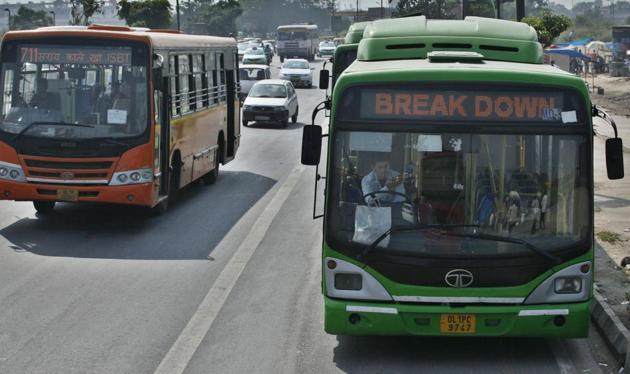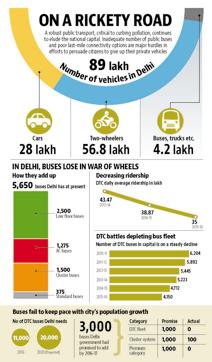Odd-even 3.0 faces bus shortage challenge
Delhi government’s inability to decide on the size of buses required for its roads has stalled plans of adding buses to the depleting Delhi Transport Corporation (DTC) fleet.
Delhi government’s inability to decide on the size of buses required for its roads has stalled plans of adding buses to the depleting Delhi Transport Corporation (DTC) fleet.

According to the sources, the finance department has asked the transport department to reconsider the proposal of buying mini buses as it may in the long run burden the exchequer. Mini buses can carry up to 35 passengers at a time while standard floor buses can carry up to 70. The transport department needs to deploy the same number of staff for operating both the buses.
“We will be paying the same salary to the drivers and conductors and support staff irrespective of whether they work on mini or standard floor buses. So, in mini buses the same staff will be able to carry fewer passengers, which means we are not fully utilising the staff. That is why, to make it more cost efficient, we need to have standard floor buses. Standard floor buses will also reduce congestion,” said a Delhi government official.
Sources said that proposal has been prepared to procure 3,064 buses, but the size of these buses will be finalized by the chief minister. While a standard bus costs about Rs 42/km to operate, the cost of running a mini bus is Rs 20/km.
“There should be a mix. On some routes you need large buses, but if you want to provide door step service then mini buses are required. In a multimodal system, you need to have different size of buses. The size should be demand based,” said AK Bhattacharya, advisor, sustainable mobility, CSE.
Sources in the transport department said that the government will identify long routes and these routes will be complemented by feeder routes, where smaller buses will ply.
Buses in the national capital meet more than 60% of people’s travel demand. However, no new buses have been added to the existing fleet in the past six years.
With just 4,150 buses covering around 557 routes, the fleet of DTC is at a six year low. Estimates suggest that by January next year, the number of DTC buses is further likely to come down to 3,775 buses as about 400 of the old standard floor buses are going to be phased out. In comparison, Delhi in 2010-11 had 6,204 buses plying on its roads.
As per Delhi government’s own estimates, the city at present needs at least 11,000 more buses. By 2020, this requirement is set to touch 20,000. The DTC carried 43.47 lakh passengers per day in 2013-14, which reduced to 38.87 lakh per day in 2014-15 and in 2015-16, it further came down to 35 lakh.
On the other hand, the Delhi Metro’s average daily ridership is 27 lakh.
As a result, Delhi’s roads have almost 90 lakh vehicles today, which is way more than what it can take. Besides, the government admits that half the cars plying do not comply with Bharat Stage-IV emission norms and are Bharat Stage-III compliant or below.
Vehicular emissions contributes around 20 per cent to Delhi’s fine particulate matter (PM 2.5) and 9% to PM 10, apart from other gaseous pollutants like ozone (O3), Nitrogen Oxide (Nox), Carbon Monoxide (CO), Sulphur Dioxide (SO2).
To discourage the use of private vehicles, there has to be a robust transport network to fall back upon. “In Delhi, barring the present metro system which can serve at most 10-15% of population, the quality, efficiency and reliability of public transport has been deteriorating for the last 3-4 years. This has led to a gradual decline in the number of public transport users and increase in private motor vehicles. Delhi needs to reverse this trend and strengthen its public transport,” said Nalin Sinha, programme director, Institute for Transportation and Development Policy (India).

Stay updated with all top Cities including, Bengaluru, Delhi, Mumbai and more across India. Stay informed on the latest happenings in World News along with Delhi Election 2025 and Delhi Election Result 2025 Live, New Delhi Election Result Live, Kalkaji Election Result Live at Hindustan Times.
Stay updated with all top Cities including, Bengaluru, Delhi, Mumbai and more across India. Stay informed on the latest happenings in World News along with Delhi Election 2025 and Delhi Election Result 2025 Live, New Delhi Election Result Live, Kalkaji Election Result Live at Hindustan Times.





